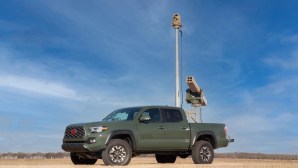After nearly 5 years of litigation, Navy awards next system in advanced airborne electronic attack

At long last, the Navy has awarded a contract for the next portion of its premier airborne electronic attack capability.
The Defense Department announced on Aug. 26 that L3Harris won a five-year, $587.4 million contract for the engineering and manufacturing development of the Next Generation Jammer Low Band (NGJ-LB) system. The NGJ family of systems is a replacement for the decades-old ALQ-99, that will be mounted on the EA-18G Growler aircraft.
The program was initially broken up into three separate jamming pods covering various ends of the electromagnetic spectrum based on criticality of current and emerging threats: Mid-Band (which was awarded to Raytheon in 2016), Low-Band and High-Band (for which there hasn’t been any line item in Navy budgets since at least fiscal 2020).
The Low Band program is a collaboration with the Australian military, according to Navy budget documents. It is intended to counter a larger capacity of enemy systems in the low-frequency electromagnetic spectrum and is scheduled to reach early operational capability in 2029, according to the Navy.
Overall, the pods in the program are expected to be significantly more powerful than the ALQ-99, with extended range and the ability to jam multiple targets simultaneously. With the increase in sophistication and range of adversaries’ military systems — especially across the Pacific — such a jamming capability could be critically important for U.S. forces in future conflicts.
The Low-Band is coming off a lengthy litigation battle, which involved a stop-work order issued by the Government Accountability Office that effectively rendered the program stalled.
L3Harris, which won the bid for low-band over Northrop Grumman, filed suit in September 2021 in the Court of Federal Claims protesting a decision by the GAO that required the Navy to potentially reopen proposals for the effort.
The GAO sided with Northrop, which alleged the Navy failed to consider the potential conflict of interest of a former Navy employee that developed specifications for the program while simultaneously negotiating for employment with L3Harris during the solicitation.
Complicating matters further, the service during the Low-Band bid process awarded two companies under a demonstration of technologies and planned to choose the best solution for the ultimate award. One company was Northrop Grumman — which teamed with Harris — and the other was L3 (at that time, L3 and Harris had not yet merged).
The Navy, along with the companies, came to an agreement and reopened bids for the Low-Band program.
Now, with a contract award, the Navy can get to work on this critical capability.
“NGJ-LB will meet current and emerging electronic warfare threats and increase the lethality of 4th and 5th generation platforms and strike weapons,” Rear Adm. John Lemmon, program executive officer for tactical aircraft programs, said in a release this week. “The Navy will partner with L3Harris to get this key capability into the hands of the warfighter.”
“Our Next Generation Jammer – Low Band solution provides the U.S. Navy with the latest digital, software-based technologies to address advanced and emerging threats from peer adversaries,” Christopher E. Kubasik, chair and CEO of L3Harris, said in a statement Thursday. “L3Harris is proud to support the Navy’s efforts to extend U.S. air superiority and operate seamlessly with coalition forces.”
The company noted it will deliver eight operational prototype pods to Naval Air Systems Command for fleet assessment and additional test assets for airworthiness and design verification over the next five years.
In 2023, the Navy initiated a change to the Mid Band program to develop an extended pod, NGJ-MBX, to provide increased range and address specific gaps. This capability provides a frequency extension of the Mid-Band as the quickest way to address near-term threats in light of the High Band capability that remains unfunded.






